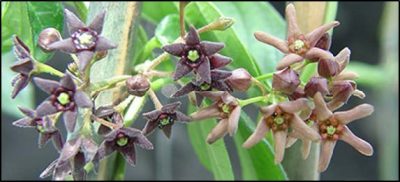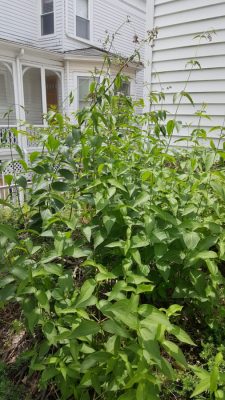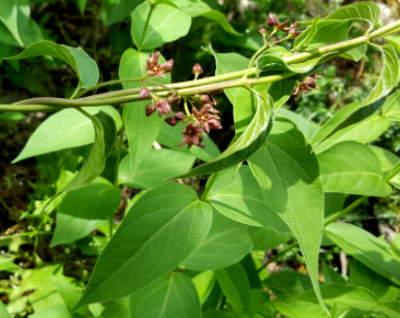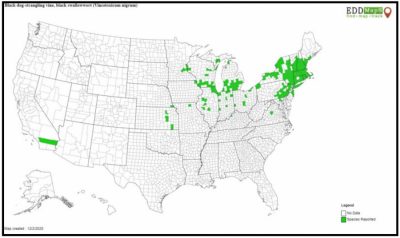Vincetoxicum nigrum; syn. Cynanchum louiseae
Vincetoxicum rossicum; syn. Cynanchum rossicum
By Victoria Wallace, Alyssa Siegel-Miles, and Klaudia Sowizral, UConn Extension
Identifying Features

- OVERVIEW: Perennial, herbaceous climbing vine. 3-9 ft. long, spiraling around self and up other plants in extensive patches. Vines can also trail along the ground; the plant cannot stand upright without support. Laboratory studies have shown allelopathic effects (release of chemicals that suppress neighboring plants’ growth).
- LEAVES: Long, oval, and opposite, with a pointed tip; 3-4 in. long, 2-3 in. wide, with smooth edges; dark, glossy green, drying to bright yellow. Stems are twining; covered in downy hairs, clear sap runs when stem is broken.
- FLOWERS: Flat, star-shaped, with 5 fused petals, forming a short tube at the base. Flowers form in early summer and grow in clusters along the length of the stem. Black swallow-wort has dark purple, triangular petals about 1/8 in. long; pale swallow-wort has slightly longer, dull pink to burgundy petals.
- SEED: 1.5-3 in. long pods; smooth, slender, and resembling milkweed pods in both species. Pods change from green to yellow to brown, then split on one side to release mature windblown seeds in late summer to autumn. Flat, brown seeds are attached to white fluffy hairs, which help the seeds disperse.
- ROOTS: Dense and fibrous root system.
- REPRODUCTION/SPREAD: Capable of self-pollinating, although sexual reproduction is more common. Colonizes new sites by seed; once established, spreads locally via rhizomes. A square-meter stand can produce 1,000-2,000 seeds per year. Plants initially grow slowly and do not reproduce by seed for the first several years.

Habitat
Swallow-wort prefers full sun, but also grows well in woodland, even densely shaded, areas. While drought tolerant, swallow-wort can also tolerate periods of brief flooding. Spreading quickly once established, it is typically found in disturbed areas, such as old pastures and fields or road ditches. Also common along roadsides, in gardens, meadows, urban areas, agricultural fields, and woodlands. Once established, it can spread across a site, displacing native species.
Control
Controlling large populations of swallow-wort requires a multi-year effort. Multiple, simultaneous control strategies are most effective. Plans for re-vegetating sites should be incorporated into control efforts, as newly exposed sites are vulnerable to reinvasion. Annual monitoring is required for successful control.

MECHANICAL CONTROL: Most effective in the initial stages of invasion; may be used as a supplement to chemical controls.
- Hand-pulling/digging: Most successful with new, small populations of very young plants. Plants may be dug out if it is possible to remove the entire root crown. Any root that remains will likely regrow into new plants.
- Cutting/mowing: Plants should be cut after flowering - just as pods are beginning to form, but before seeds begin to mature (late June to early July) - in order to discourage the plant from re-flowering and developing seed pods. Repeated cutting will prevent production and dispersal of seeds; however, regrowth from root crowns will occur, which may result in denser infestations the following season.
- Pod removal, to prevent seed spread: In a small area, where volunteer labor is available, hand removal of pods may be considered as a method of control. In larger areas, this manual effort may not be feasible; other methods of control would be required.
BIOLOGICAL CONTROL: In 2018, Hypena opulenta, a noctuid moth, was approved as a biological control agent. Since then, this moth has been released at several sites in New England and New York. UConn Extension participated in biological control research and release in CT. Larval development of this moth occurs on mature swallow-wort. The moth is not yet available to the general public in the United States.
CHEMICAL CONTROL: Effective; typically preferred for large infestations. May require several consecutive years of repeated applications for effective control.

- Foliar sprays: Glyphosate or Triclopyr. Glyphosate should be mixed with a surfactant and should be applied once the plant has flowered (June), and then reapplied in August. Triclopyr can be applied as a foliar spray once per season and should be applied to swallow-wort once the seed pods have developed.
DISPOSAL OF PLANT PARTS: Root crowns, fragments, and seedpods should not be left on the ground or composted, as they will resprout or germinate. Hand-rogued plants should either be burned or placed in sealed bags and disposed in a municipal landfill.
Distribution
In the U.S., both species are mostly found in the northeast region: Connecticut, Massachusetts, Rhode Island, and New York. Scattered infestations in Michigan and Illinois.

Other Facts and Backgrounds
Black swallow-wort is native to regions of the western Mediterranean. Pale swallow-wort is native to the Ukraine and south-eastern European Russia. Both swallow-worts were imported from Europe in the early 1900s for their ornamental and horticultural interest. The plants produce anti-bacterial and anti-fungal chemicals, as well as toxins that are harmful to some native insects and mammals, including livestock. Swallow-worts are in the periwinkle family, Apocynaceae, and appear similar to several native species in the same family, such as milkweeds and dogbanes. Correct identification is critical. Milkweeds (Asclepias spp.) are distinguished by their milky latex sap. Dogbanes (Apocynum spp.) are distinguished as upright shrubs, with bell-shaped flowers arranged in clusters at stem tips.
SOURCES:
- Connecticut Invasive Plants Council. (2018, October). Connecticut Invasive Plant List. https://cipwg.uconn.edu
- Cornell Cooperative Extension, Putnam County. (Updated 2023, November 28). Swallow-worts. https://cceputnamcounty.org/natural-resources/swallow-worts
- Lowenthal, W. (2018, June 15). Invasive in the Spotlight: Swallow-wort: How to control the "dog-strangling vine" taking over your yard. University of New Hampshire Extension. https://extension.unh.edu/blog/2018/06/invasive-spotlight-swallow-wort
- Michigan Department of Natural Resources. (2012, April). Invasive Species - Best Control Practices: Black and Pale Swallow-worts.
- New York Invasive Species (IS) Information. (2019, July 5). Swallow-wort, Pale and Black. Cornell Cooperative Extension & SeaGrant New York. https://nyis.info/invasive_species/swallow-wort/
- Varricchio, E. & Connecticut Invasive Plant Working Group. (n.d.). Connecticut’s Invasive Plant Management Calendar: The Top 10 Invasive Plants [PowerPoint slides]. Connecticut Invasive Plant Working Group. https://cipwg.uconn.edu
Questions? Contact:
Vickie Wallace
UConn Extension
Extension Educator
Sustainable Turf and Landscape
Phone: (860) 885-2826
Email: victoria.wallace@uconn.edu
Web: ipm.uconn.edu/school
UConn Extension is committed to providing equal access and full participation for individuals with disabilities within all our programs and activities. Visit s.uconn.edu/accessibility for more resources. UConn is an equal opportunity program provider and employer.
©UConn Extension. All rights reserved.
Updated April 2021
  |